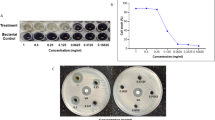Abstract
The effects of the alkali metal ions (Li+, Na+ and K+) on the growth and on certain virulence factors (adhesion, cell-surface hydrophobicity and germinating ability) ofCandida albicans were determined. High concentrations of these ions displayed an inhibitory effect on the growth of theCandida cells; preincubation in their presence showed a negative effect on all virulence factors studied. The changes induced during the preincubation remained there even when high concentration of the ions was removed from the cell suspension. In contrast, a considerable growth was found at high Na+ and K+ concentrations. Although alkali metal ions significantly decreased certain virulence traits of the fungus they did not totally inhibit adhesion and germ-tube formation. This suggests thatC. albicans may represent a health hazard even at a high salt concentration.
Similar content being viewed by others
References
Bonde G.J.: Bacterial indicators of water pollution.Adv.Aquat.Microbiol. 1, 273–364 (1977).
Brisou J.: Yeasts and fungi in marine environments.Bull.Soc.Fr.Mycol.Med. 4, 159–162 (1975).
Cutler J.E.: Putative virulence factors ofCandida albicans.Ann.Rev.Microbiol. 45, 187–218 (1991).
Dichtl B., Stevens A., Tollervey D.: Lithium toxicity in yeast is due to the inhibition of RNA processing enzymes.EMBO J. 16, 7184–7195 (1997).
Dorko E., Pilipčinec E., Tkáčiková L.:Candida species isolated from cerebrospinal fluid.Folia Microbiol. 47, 179–181 (2002).
Fekete-Forgács K., Gyüre L., Lenkey B.: Changes of virulence factors accompanying the phenomenon of induced fluconazole resistance inCandida albicans.Mycoses 43, 273–279 (2000).
Ghinsberg R.C., Bar Dov L., Rogol M., Sheinberg Y., Nitzan Y.: Monitoring of selected bacteria and fungi in sand and sea water along Tel Aviv coast.Microbios 77, 29–40 (1994).
Gorga F., Galdiero E., Donnarumma G., Salerno G., de Martino L.: Ultrastructural and biochemical studies onCandida albicans after prolonged incubation in sea water.FEMS Microbiol.Lett. 145, 167–172 (1996).
Jautová J., Virágová S., Ondrašovič M., Holoda E.: Incidence ofCandida species isolated from human skins and nails: a survey.Folia Microbiol. 46, 333–337 (2001).
Klotz S.A., Drutz D.J., Harrison J.L., Huppert M.: Adherence and penetration of vascular endothelium byCandida yeasts.Infect. Immun. 42, 374–384 (1983).
Kretschmar M., Hube B., Bertsch T., Sanglard D., Merker R., Schröder M., Hof H., Nichterlein T.: Germ tubes and proteinase activity contribute to virulence ofCandida albicans in murine peritonitis.Infect.Immun. 67, 6637–6642 (1999).
Mates A.: Quantitative determination ofCandida albicans in sea water.Microbios 78, 27–30 (1994).
Northrop F., Ljubojevic S., Davies J.M.: Influence of Na+ and anions on the dimorphic transition ofCandida albicans.Microbiology 143, 3757–3765 (1997).
Odds F.C.:Candida and Candidosis, 2nd ed. Bailliere Tindall, London 1988.
Rosenberg M., Gutnick D., Rosenberg E.: Adherence of bacteria to hydrocarbons: a simple method for measuring cell-surface hydrophobicity.FEMS Microbiol.Lett. 9, 29–33 (1980).
Singleton D.R., Masuoka J., Hazen K.C.: Cloning and analysis of aCandida albicans gene that affects cell surface hydrophobicity.J.Bacteriol. 183, 3582–3588 (2001).
Suzuki S., Yasue T., Ohashi M.: The roles of proteinase production and germ tube formation in the invasion ofCandida albicans into newborn mouse skin.Nippon Hifuka Gakkai Zasshi 99, 1227–1234 (1989).
Tomšíkova A.: Causative agents of nosocomial mycoses.Folia Microbiol. 47, 105–112 (2002).
Valdes-Collazo L., Schultz A.J., Hazen T.C.: Survival ofCandida albicans in tropical marine and fresh waters.Appl.Environ.Microbiol. 53, 1762–1767 (1987).
Author information
Authors and Affiliations
Corresponding author
Additional information
This work was supported in part by theHungarian National Scientific Research Fund, grant no. OTKA T 032 473.
Rights and permissions
About this article
Cite this article
Hermann, P., Forgács, K., Gál, E. et al. Effects of alkali metal ions on some virulence traits ofCandida albicans . Folia Microbiol 48, 173–176 (2003). https://doi.org/10.1007/BF02930951
Received:
Issue Date:
DOI: https://doi.org/10.1007/BF02930951




